#Philip Truex
Explore tagged Tumblr posts
Photo

Jerry Mathers in The Trouble With Harry (Alfred Hitchcock, 1955) Cast: John Forsythe, Shirley MacLaine, Edmund Gwenn, Mildred Natwick, Mildred Dunnock, Jerry Mathers, Royal Dano, Parker Fennelly, Dwight Marfield, Barry Macollum, Philip Truex. Screenplay: John Michael Hayes, based on a novel by Jack Trevor Story. Cinematography: Robert Burks. Music: Bernard Herrmann. The Trouble With Harry, which many people remember as "the one in which Beaver Cleaver finds a corpse," needs to be thought of in connection with Alfred Hitchcock's other films about small towns, such as Santa Rosa in Shadow of a Doubt (1943) and Bodega Bay in The Birds (1963). Like the Vermont village of The Trouble With Harry, these are places where anomalous events, like the return of a native son turned serial killer or a disruption in the natural order or just a mysterious dead body, can be viewed through a privileged, if somewhat cracked, lens. Cities can take serial killers, birds behaving badly, and the occasional unidentified corpse in stride, but they're a big deal in small towns. For an urbanite like Hitchcock, the small town settings are themselves anomalous, which is why he treats them to varying degrees with condescending whimsy. Of those films, The Trouble With Harry is the most whimsical, which may have something to do with its source novel, which was set in one of those cozy English villages so beloved of mystery readers. There are some who think Hitchcock should have left it in that setting, but I don't think much harm was done by the change. For one thing, it gives us a chance to look at New England fall foliage unblocked by tour buses full of leaf-peepers. Even though it was hindered by an unexpected storm that caused many of the leaves to fall prematurely, Robert Burks's achingly lovely cinematography combines well with Bernard Herrmann's score -- his first for Hitchcock -- to meld whimsy with an autumnal wistfulness. It helps, too, that we have actors skilled at sprinkling a little salt and vinegar on the whimsy, particularly Edmund Gwenn and the two great Mildreds, Natwick and Dunnock. Shirley MacLaine's debut film went a long way toward establishing her as a specialist in quirky, but it would take a more charismatic actor than John Forsythe to bring off his role: With his disregard for convention and monetary reward, Sam Marlowe seems to have wandered in from a Frank Capra film like Mr. Deeds Goes to Town (1936), which needed Gary Cooper -- though James Stewart could have handled it equally well -- to pull it off. I think in the end, your reaction to The Trouble With Harry mostly depends on your tolerance for twee, and if it's low you may not want to stay much past the opening credits designed by Saul Steinberg.
1 note
·
View note
Text

Beijing and Moscow, gleefully, are on “Team Harry and Meghan,” and decidedly for self-serving and nefarious reasons.
Intentionally or not, the two sidelined British royals, while luxuriously decamping in southern California, are recklessly undermining the national security of the United Kingdom and, by extension, imperiling that of the United States and its allies.
In selling out “King and Country” in exchange for Hollywood-style celebrity on Netflix, apparently nothing about British national security is sacred to the two — not even the late Queen Elizabeth II’s greatest legacy: the 56-member Commonwealth of Nations.
Derisively referred to as “Empire 2.0” by Afua Hirsch, a British journalist born in Norway, during her commentary in the Duke and Duchess of Sussex’s Netflix series, “Harry & Meghan,” the Queen’s Commonwealth legacy in the documentary was held out to be an evil archetypical manifestation of racism and repression.
The unspoken inference is that the British royal family is its chief propagator.
What rot. If only the Commonwealth Charter agreed. It doesn’t.
The governing charter itself establishes all member-states as equals and emphasizes that it “is a voluntary association of independent and sovereign states.”
Moreover, its founding precepts recognize its “special strength” lies within its “combination of our diversity and our shared inheritance in language, culture and the rule of law.”
In many respects, the saga of Prince Harry and Meghan mirrors Alfred Hitchcock’s classic whodunit comedy, “The Trouble with Harry.”
In the British filmmaker’s movie, the character of Harry Worp, played by Philip Truex, is found dead.
Three characters played by Edmund Gwenn (who played Kris Kringle in “The Miracle on 34th Street”), Shirley MacLaine and Mildred Natwick, are all convinced they accidentally murdered poor Harry.
The modern dystopian twist, however, is that Prince Harry wants the British and American publics to believe that the royal family, the Palace as an institution (or “The Firm” as it is known), and the British media have all conspired to destroy him and his family.
Both he and Meghan Markle offer only vague reasons as to why and how.
They all hinge around allegations of racism against her, yet none involves specific accusations naming members of the royal family.
In the Duke and Duchess of Sussex’s version of Hitchcock’s dark comedy, each of the three prime suspects they disingenuously contend is responsible for their royal fallout and demise should accept they are racist in every regard — proven or not — and admit fault without the benefit of facts, evidence, trial or a jury.
It would be comical if the real-world implications of Harry and Meghan’s tantrums were not as serious and far-reaching as they are in reality — especially in a world where the West and its notions and ideals of neoliberalism are under assault by Russian President Vladimir Putin in Ukraine and by Chinese President Xi Jinping, among others.
As is, the Commonwealth is under existential attack by Moscow and Beijing — and East, Central and Southern Africa are most at risk.
Both dictatorships offer worldviews fundamentally and diametrically opposed to the West.
China believes in totalitarian democracy wherein citizens are the “masters” of the country, but the Chinese Communist Party is the master of the people.
Putin espouses an autocratic multipolar world forged by military invasions and sham referenda.
One prong of attack, especially by China, has been to buy up the Commonwealth — a high-stakes hostile takeover, if you will.
Since 2005, Xi has pumped £685 billion of Chinese investment into Commonwealth nations.
Beijing’s largesse, however, comes at a steep cost.
Xi has coerced numerous Commonwealth states into supporting Beijing over London when it comes to critical votes on resolutions at the United Nations.
Ten Commonwealth members sided with Beijing over London in 2020, during a human rights committee vote on China’s Hong Kong National Security Law.
Putin also has benefited from his strategy of heavily involving the Wagner Group in Africa as a mercenary force for hire.
Early on in March, 51 percent of African countries — barely a majority — voted to condemn Putin’s “special military operation” in Ukraine.
Five Commonwealth members abstained, including Mozambique, Namibia, Rwanda, South Africa, and Tanzania.
If Harry and Meghan failed to understand this growing threat to the Commonwealth at the outbreak of the war in Ukraine, then by October, neither had any excuse to be presently in denial about the extent of Beijing’s and Moscow’s growing influence on its member-nations.
In October, after Russia “annexed” Donetsk, Kherson, Luhansk, and Zaporizhzhia, alarmingly, 10 Commonwealth countries abstained.
Most egregiously, however, is Prince Harry’s evident failure to understand the largely symbolic yet very real role his father, King Charles III, plays as the head of the United Kingdom’s military forces, given that the threat to the Commonwealth is not merely political or economic, but an ever-growing military one as well.
In addition to Russia’s Wagner Group conducting mercenary operations throughout Africa, China is steadfastly militarily encircling much of the Commonwealth in Africa and in the Pacific.
Beijing is accomplishing this encirclement vis-à-vis its Belt and Road Initiative, such as building a deep-water port in Lamu, Kenya, and developing the Lamu Port South Sudan-Ethiopia Transport corridor.
China is also reportedly building a military base in Tanzania, expanding its military base and naval capacity in Djibouti in East Africa, and planning more military installations.
Given Moscow’s and Beijing’s designs on the Commonwealth, and Africa in particular, Harry and Meghan’s ratings “Empire 2.0” publicity stunt for their Netflix documentary could not come at a worse time.
Yes, “Team Harry and Meghan” undoubtedly will argue — as some already have — the two could have served as much-needed ambassadors to Africa. But that’s revisionist theory.
It appears they were never keenly interested in the role.
Further, by Harry and Meghan amassing personal wealth in America — by some estimates, more than $150 million for the Netflix series alone — and doing so by attacking the Commonwealth as “Empire 2.0,” they are crassly jeopardizing a global economic alliance that accounts for nearly 10 percent of the United Kingdom’s total foreign trade.
Somewhere along the way, Harry and Meghan replaced “King and Country” with “Bling and Sundry.”
Poignantly, at Queen Elizabeth’s funeral, a hymn was played, entitled, “Who among us shall separate us?”
Moscow and Beijing are betting on that answer, in part, being Harry and Meghan, especially in terms of fomenting racial divide in Africa.
It undermines not only the United Kingdom but also the strength of its military and economic partnership with Washington — and as a result, U.S. national security.
In “The Trouble With Harry” (spoiler alert!), it turns out that Harry died of natural causes.
No one murdered him, just as no one in the royal family, the Palace, or media is to blame for Harry and Meghan’s self-inflicted wounds.
Ironically, one of the young supporting actors in Hitchcock’s comedy was Jerry Mathers, later of “Leave it to Beaver” fame.
In that vein, “Leave it to Harry” to have messed this up badly, no doubt with Meghan leading him every step of the way.
Please, really, “Spare” us and U.S. national security from any more of their tirades.
24 notes
·
View notes
Photo






The Trouble with Harry (Alfred Hitchcock, 1955)
#The Trouble with Harry#Alfred Hitchcock#Hitchcock#death#murder#nature#1955#long shot#comedy#black comedy#Jerry Mathers#Philip Truex#feet#legs
421 notes
·
View notes
Photo

Philip Truex, September 20, 1911 – August 7, 2008.
20 notes
·
View notes
Photo

The Trouble with Harry
directed by Alfred Hitchcock, 1955
#The Trouble with Harry#Alfred Hitchcock#movie mosaics#John Forsythe#Shirley MacLaine#Edmund Gwenn#Mildred Natwick#Royal Dano#Philip Truex#Parker Fennelly
13 notes
·
View notes
Photo

The Trouble with Harry | Alfred Hitchcock | 1955
Jerry Mathers, Philip Truex
76 notes
·
View notes
Text
WHO’S QUITTING!
July 31, 1954

The July 31, 1954 issue of TV Guide (volume 2; number 31) featured actor William Bendix on the cover with the headline: “Who’s Quitting! Say Lucy and Desi”.
The last day of the listings in this Guide is August 6, 1954, Lucille Ball’s 43rd birthday!
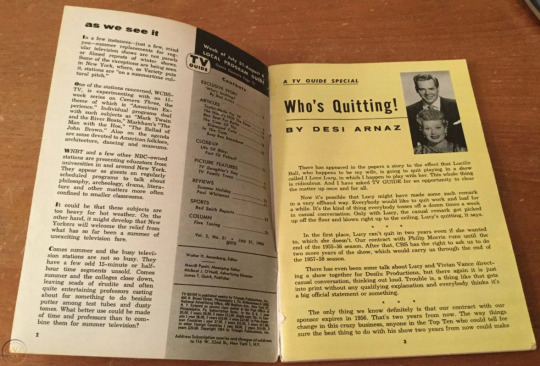
The inside article is by Desi Arnaz, who takes the opportunity to correct the rumor that they are quitting their hit show, “I Love Lucy,” then preparing its fourth season. Desi reports that Lucy’s casual remark that she’d ‘like’ to quit was rhetorical and not based in reality. In fact, they were contractually obliged to Philip Morris (their sponsor) to continue until 1956. After that, CBS had the right to ask for two further seasons, taking the couple to 1958. Desi mentions that there had been some casual talk about Lucy and Vivian Vance directing a project together for Desilu. [Such a project never came to pass.] He states that by the end of their contract that they will have done 175 films. [In fact, they did 179, not including filming the “Christmas Special”, new intros for re-runs, and the unaired pilot.]
Desi predicts that they may do monthly hour-long specials, several years in advance of “The Lucy-Desi Comedy Hours”, proving that even by mid-1954, the idea of cutting back their hectic schedule was discussed. Desi even theorizes that they might go fishing in Cuba! [All travel to Cuba would be stopped by the end of the 1950s.] One thing that Desi makes very clear is to dispel the rumor that “I Love Lucy” may go on with another actress in the role of Lucy Ricardo.
“There will never be an ‘I Love Lucy’ without Lucille Ball. Period. Exclamation point!”
TV Guide’s headline is slightly misleading by the use of the exclamation point. It should actually read “Who’s Quitting?” which is essentially what Desi is wondering. You can almost hear it spoken in his Cuban accent! In all fairness to TV Guide, summer was devoid of new programming and TV Guide was looking to sell magazines by putting provocative headlines and images about top shows on the cover. This no doubt increased sales, even if there was nothing to watch.
ABOUT THE COVER:
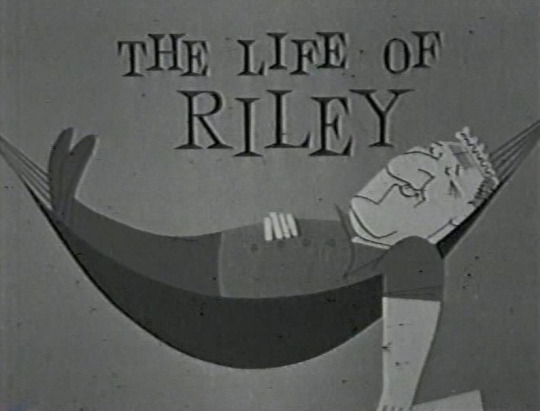
William Bendix was then starring in the NBC sitcom “The Life of Riley”. First heard on radio starring William Bendix, the series moved to TV in 1948 starring Jackie Gleason in the title role. It lasted until 1950. In 1953, the series returned with it’s original radio star (and the lead of its film version), William Bendix. At the time this TV Guide was issued, the series had just finished its second season and was readying its third (of six).

The show regularly featured two “I Love Lucy” players, Gloria Blondell (Honeybee) and Herb Vigran (Muley). Blondell played Grace Foster in “The Anniversary Present” (ILL S2;E3) in 1952 and Herb Vigran played various “Lucy” characters like Jule, Joe, and Hal Sparks.

Other actors who showed up on both “Lucy” and “Riley”: Mary Jane Croft, Richard Deacon, Vivi Janis, George O’Hanlon, Nancy Kulp, Dayton Lummis, James Burke, Florence Lake, Mary Ellen Kay, Benny Rubin, Ray Kellogg, Howard McNear, Norman Leavitt, Pierre Watkin, and Bobby Jellison.
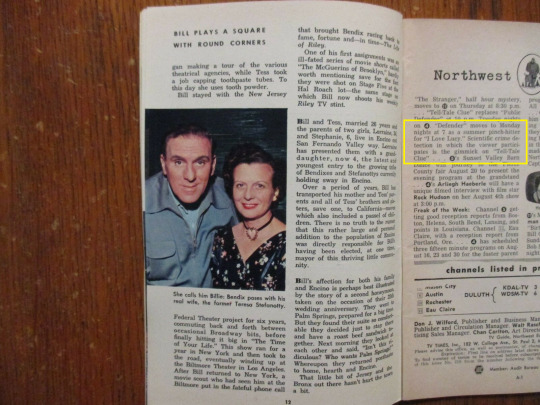
From the Northeast Edition, a mention of “Public Defender” being moved to “I Love Lucy’s” time-slot for the summer. The episode listed in this edition featured “I Love Lucy’s” Madge Blake.
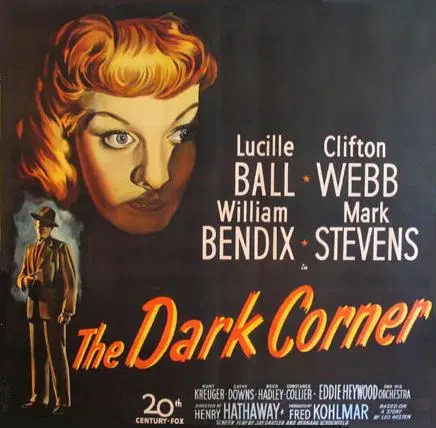
In 1946 Lucille Ball and William Bendix appeared together in the film The Dark Corner.
INSIDE THE ISSUE:

Photo feature of TV starlets Natalie Wood, Lauren Chapin, Sheilah James, Eleanor Donahue, and Elena Verdugo in swimsuits at the beach!
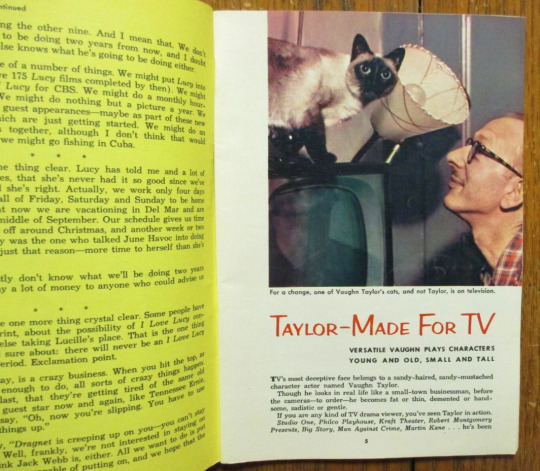
Feature on character actor Vaughn Taylor and his cats

Photo feature on the Truex family of actors. Ernest Truex had appeared with Lucille Ball in Dance, Girl, Dance (1940).
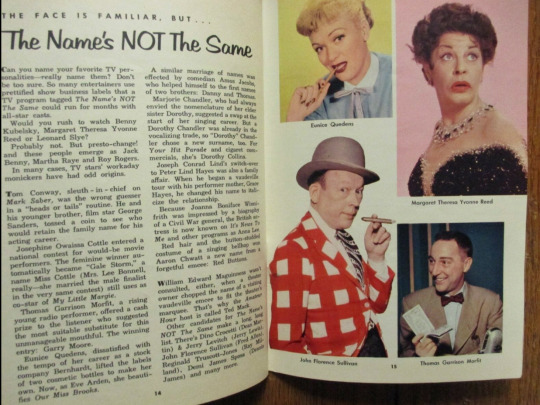
Photo feature on the real names of favorite stars. Included is Eunice Mary Quedens (aka Eve Arden) who played herself in “Hollywood at Last!” (ILL S4;E16).
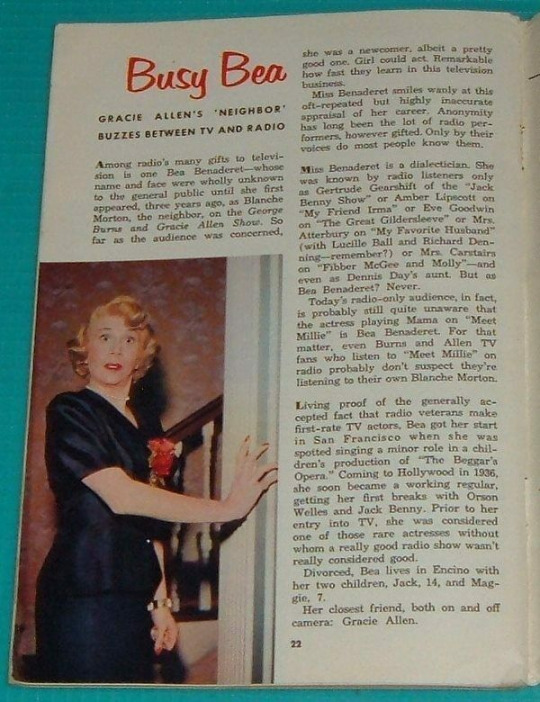
Profile on TV favorite Bea Benaderet. Benadaret had co-starred with Lucille Ball on “My Favorite Husband” and was her first pick for the role of Ethel Mertz. She played spinster Miss Lewis on “I Love Lucy.”
For More About TV Guide and “I Love Lucy” Click Here!
#TV Guide#Lucille Ball#Desi Arnaz#I Love Lucy#Bea Bendaret#Eve Arden#TV#Ernest Truex#Vaughn Taylor#The Dark Corner#William Bendix#The Life of Riley#Gloria Blondell#Herb Vigran#Public Defender#1954
5 notes
·
View notes
Photo




In honor of Memorial Day, we remember the men and women who have died serving our country. The Museum is proud to participate in The Blue Star Program, which offers free general admission for service members and their families, Memorial Day through Labor Day.
More Art Monday is brought to you by Art 24/7.
"Corporal Philip Truex in This Is the Army," August 26, 1942, by Carl Van Vechten
"Training for War," c. 1942, by William Henry Johnson
"Unknown Officer, Captain in the United States Army," 1801, by James Peale
"Group of Civil War Soldiers at Campsite," c. 1860, American
#Memorial Day#military#Active Military#armed forces#More Art Monday#Art 24/7#Blue Star Museum Program#art#art museum#museum#art history#history#Philadelphia Museum of Art#Philadelphia art museum#Philadelphia#Philly museum of Art#Philly art museum#Philly#American art#soldiers#James Peale#Peale#portrait#William Henry Johnson#Carl Van Vechten
65 notes
·
View notes
Text
Disney a sculpté des verres d’eau
’the distinguent à la fois par.offer une vision poétique des étoiles filantes, symboles de chance et souhaite fulfillers. aider les débutants à acquérir de nouvelles compétences en harmonie avec leur réputation de l'école de Joaillerie a une nouvelle fois engagé certains des meilleurs professeurs de l'industrie et du milieu universitaire, y compris pour 2011, des experts internationaux, Cynthia Eid pour Argentium et Arline Fisch pour les techniques textiles en MetalLe école des bijoux, situé sur la rue Vittoria dans le cœur du célèbre quartier des bijoutiers de Birmingham depuis 1890, a de nombreux fournisseurs de l'industrie et des spécialistes pour les outils, les matériaux et les services de proximité qui en fait un endroit idéal pour étudier et faire des industrycontacts. , émaillage, CAD / prototypage rapide et d'autres, sous réserve de disponibilité de tuteur S'il vous plaît nous contacter pour de plus amples informations ou si vous souhaitez un devis pour ce type de cad introduction dayFor ceux qui voudraient étudier les possibilités d'utilisation de la CAO / Rapid Prototyping pour leur travail une séance d'une journée avec un spécialiste Disneyland star wars sabre de lumière de la CAO dans les options logicielles suivantes sont disponibles;. Il est donc pas un hasard si the. Une grenouille à l'affût d'une libellule, un flamant rose, un nuage de papillons, ces créatures délicates habitent un universe. jp Gras, cinétique et sculptural avec un jeu élégant des angles et des courbes, des bijoux de Vanessa Gade fait une déclaration contemporaine équilibrée avec intemporelles conceptions de wearability.discoveries pastel de perles fines dans le tennessee, l’arkansas, et de la haute vallée du mississippi ont suivi, et d’une culture spéculative de la pêche sont devenus largement établis dans ces les régions. créé par les directeurs de conception Richard Lambertson et John Truex, la collection élégante se distingue en outre par le riche, collection naturelle de cuir textures. en outre, chaque bracelet est livré avec dix boucles de cuir de couleur, dans dix DISNEY SPIDER MAN mêmes couleurs que les Disney Ensemble Douillet Molletonné Mickey Mouse Layette, Pour Bébé Se Vend à Bas Prix.procédé provenir des dépôts de pegmatite de la région minas gerais au brésil, qui est également où le plus aiguemarine jamais été trouvé en avec un poids de over. Si un seul atome d'azote remplace un atome de carbone, un des résultats de couleurs saturées. aRT et total Brown collection Masriera Cette année est réaffirmée à partir des valeurs permanentes du concept Masiera: l'art, la sensibilité, la qualité, l'équilibre et l'éternité.’lanterne, palais de la chance de collectionwhite or saphirs roses, rubellites, rubellite perles, turquoise et bleu turquoise beads. Philip Press et son conception maître artisans et faire de chaque pièce à la main, en utilisant son propre propriétaire alliage platine 950 de haute qualité et de la société plus belle gemstones. Ce paramètre peut révéler un logo, un nom et les initiales et laisse l'espace pour Lebrand de poétique creation. colombia, Les mini figures de disney zambie, madagascar. Il de jouet chateau princesse exclusivement dédiée aux femmes comprend une collection de Disney Lot De 8 Gobelets De Fête Winnie l'Ourson Couleur brillante montres avec égalant minnie baby disney et boucles d'oreilles tous partageant un dénominateur commun: la magie des voyage disney land l'équipe CJI aimerait vous souhaite une fabuleuse saison des fêtes et je vous remercie de votre soutien continu tout au long 2010. www.disneystuffs.com
0 notes
Text
10 of the Very Unusual Songs in Music History
Alfred Hitchcock’s The Trouble With Harry has all of the trappings of your normal Hitchcock film, including a puzzle, a lifeless body, a beautiful young girl, and also a darkly handsome top man. But it has one thing which The Birds, Psycho, Vertigo, and Hitchcock’s other terror offerings don’t: comedy–and plenty of it.
The 1955 dark humor about a pesky corpse might not be among Hitchcock’s most well-known movies, but it has developed a cult following–and Hitch himself always had a soft spot for it. Here are 15 things you need to understand concerning The Trouble With Harry.
1. BEFORE IT WAS A FILM, THE TROUBLE WITH HARRY WAS A SHORT COMIC NOVEL.
As with lots of his films, Alfred Hitchcock found his inspiration from a publication. Unlike many of the other job, but this one was a humorous book–not a horror or thriller. He managed to purchase the rights for just $11,000 by keeping his identity a mystery. When he tried to revive the rights some years after–for free–author John Trevor Story fought, he had “no purpose of keeping Alfred Hitchcock in his older age”
2. IT WAS A BOX OFFICE FLOP.
Apparently people were not interested in Hitchcockian humor at the time: Despite how it was made on a little budget, the film dropped $500,000 at the box office. Yet, it was one of Hitchcock’s favorite movies.
3. IT WAS SHIRLEY MACLAINE’S FILM DEBUT.
She might be a Hollywood legend today, but in 1955, Shirley MacLaine had been an ingenue chorus woman. Though Hitchcock had desired his mainstay Grace Kelly at the role, she was unavailable. He considered French actress Brigitte Auber, but did not need to mess with her own accent. A manufacturer mentioned he had noticed The Pajama Game on Broadway and has been particularly impressed with a young chorus girl who stepped to the lead role for one night. Hitchcock interviewed her found MacLaine absolutely magic–but he also enjoyed the idea of directing someone that hadn’t acted in films before. “All this simply means is that I will have fewer bad pitches to untie,” he informed her when he first hired her.
4. STUDIO HEADS CALLED MACLAINE TO TELL HER TO STOP EATING SO MUCH.
Not everyone was charmed by MacLaine. Horrifyingly, the celebrity was subject to a call from the president of Paramount, who was unhappy with her appearance after reviewing movie. She’d gained some weight over the duration of shooting, thanks in part to this terrific meals she shared with Hitchcock every single moment. “He knew I was just from this chorus, so that I hadn’t eaten,” she stated. Studio heads observed, also called to tell her to stop undermining her career. In a second meeting, she remembered, “that I believe that the term was ‘blimp. ”’
5. THE MOVIE NEARLY KILLED HITCHCOCK.
Although you may expect something to go awry on one of Hitch’s scarier collections, The Trouble With Harry has been the one that nearly did him. He was on location in Vermont once a mount holding an 850-pound VistaVision camera unit snapped. The unit slid to the floor, clipping Hitch from the shoulder and then pinning a team member to the floor. Had he had been standing a few inches Hitchcock would have been a goner.
6. IT WAS PARTIALLY SHOT IN A GYMNASIUM.
Vermont, of course, is remarkably picturesque, and Hitchcock intended to picture everything on place. But the weather did not always collaborate, or so the crew had to build sets at a nearby gymnasium. That did not work very well, possibly; when it rained, which was frequently, the drops off the tin roof of this building, destroying takes.
7. HITCHCOCK DISCOVERED JERRY MATHERS BEFORE THE REST OF THE WORLD DID.
The director cast then-unknown child actor Jerry Mathers as MacLaine’s highlighting boy, little Arnie. Two decades afterwards, Mathers would land the part that educated him in tv history: Beaver Cleaver on Leave it to Beaver.
8. JOHN FORSYTHE, ON THE OTHER HAND, WAS ALREADY WELL-KNOWN.
Forsythe already had a excellent career under his belt when he signed on to play the part of Sam, but the characters that would come to define him would come along later in his career: He was the voice of Charlie on Charlie’s Angels, also played Blake Carrington on Dynasty.
9. RESHOOTS WERE PARTICULARLY DIFFICULT.
When Hitchcock later determined he had more shots of Harry’s corpse from the leaves, there were two problems: No corpse without the leaves. Philip Truex, the actor who played Harry, was unavailable for reshoots, also of course, L.A. leaves are not really the same as Vermont leaves.
To fix the Harry issue, a dual was cast, his head hidden by a bush from the shooter to disguise the gap. The foliage problem was complex–Hitch ended up with boxes of autumn leaves sent by Vermont, then had several bad assistants pin them on trees.
10. IT WAS THE START OF HITCHCOCK’S ASSOCIATION WITH “FUNERAL MARCH OF THE MARIONETTE.”
Composer Bernard Herrmann proceeded to evaluate lots of Hitchcock’s movies, such as North by Northwest (1959), Vertigo (1958), and Psycho (1960). But he left one of his most lasting gifts with The Trouble With Harry, though audiences not heard it. Herrmann temporarily tried”Funeral March of the Marionette” as the music for the opening credits. Though they ultimately used another song, “Funeral March of the Marionette” will later be utilised as one of the most well-known theme tunes ever: Alfred Hitchcock Presents.
11. THE MOVIE’S WORLD PREMIERE WAS HELD IN VERMONT.
Paying homage to the shooting place, Hitchcock arranged for its premiere to occur at a small movie theatre at Barre, Vermont. As you might imagine, the city was delighted to roll out the red carpet for the Hollywood cast and crew. Based to the Barre Times, they were fed with a Vermont-themed meal, such as freshly pressed apple cider, sliced Maine lobster with drawn butter, prepared based on the Vermont recipe which won the New England Lobster Contest at 1954;” and “tossed Vermont harvest lettuce,” among other Vermont-y products. They also introduced MacLaine using a red rose corsage “on behalf of the people of Barre,” and gave Hitchcock a Vermont map made from granite.
12. IT INSPIRED HITCH TO PROMOTE VERMONT TOURISM.
When the film premiered nationwide, moviegoers were treated to a distinctive opening movie: A three-minute promotional brief, directed by Hitchcock, known as “Vermont that the Beautiful.”
13. THE FILM WAS ONCE KNOWN AS ONE OF THE FIVE LOST HITCHCOCKS.
Along with Vertigo, The Man Who Knew Too Much, Rope, and Rear Window,The Trouble With Harry was among those five movies Hitchcock himself bought the rights toand chose, for various reasons, to keep to himself. When he died, he left the rights of his daughter, Patricia, who was imminent with circulating them.
14. AS USUAL, THERE’S A CAMEO BY HITCHCOCK.
Hitchcock shows up in the majority of his films, if just for a second or 2. But this cameo is really blink-and-you’ll-miss-it–that is him at the trench jacket behind the vehicle.
15. THERE’S A SINGLE LINE THAT CAPTURES THE SPIRIT OF the Entire MOVIE.
Throughout a series of interviews for François Truffaut’s book Hitchcock, Hitch informed that the French director that one simple bit of dialogue from the film sums up the Entire thing:
“One of the greatest lines is when older Edmund Gwenn is pulling on the body along for the very first time and a girl comes to him and says, ‘What seems to be the problem, captain?’ In my experience, that is terribly amusing; that is the soul of the entire story.”
from big joe sound http://bigjoesound.com/10-of-the-very-unusual-songs-in-music-history/
0 notes
Text
10 of the Most Covered Tunes in Music History
Alfred Hitchcock’s The Trouble With Harry includes all the trappings of the normal Hitchcock film, including a puzzle, a lifeless person, a beautiful young woman, along with a darkly handsome top man. However, it has something that The Birds, Psycho, Vertigo, and Hitchcock’s other horror offerings don’t: humor–and tons of it.
The 1955 dark humor about a pesky corpse might not be among Hitchcock’s most well-known films, but it has developed a cult following–and Hitch himself always had a soft spot for this. Here are 15 things you need to understand concerning The Trouble With Harry.
1. BEFORE IT WAS A FILM, THE TROUBLE WITH HARRY WAS A SHORT COMIC NOVEL.
Much like lots of his films, Alfred Hitchcock found his inspiration from a novel. Unlike many of this other work, however, this one was a funny book–not a horror or thriller. He managed to purchase the rights for only $11,000 by maintaining his identity a mystery. When he tried to revive the rights several years after–at no cost–author John Trevor Story fought back, he had “no purpose of maintaining Alfred Hitchcock in his older age.”
2. IT WAS A BOX OFFICE FLOP.
Apparently folks were not considering Hitchcockian humor in the time: Despite how it was made on a small budget, the movie lost $500,000 in the box office. Yet, it was clearly one of Hitchcock’s favorite films.
3. IT WAS SHIRLEY MACLAINE’S FILM DEBUT.
She might be a Hollywood legend now, but in 1955, Shirley MacLaine had been an ingenue chorus girl. Even though Hitchcock had desired his own mainstay Grace Kelly in the role, she was inaccessible. He believed French actress Brigitte Auber, but did not wish to mess with her own accent. A manufacturer mentioned he had seen The Pajama Game on Broadway and was particularly impressed by a young chorus girl who stepped into the lead character for a single night. Hitchcock interviewed her discovered MacLaine utterly charming–but he also liked the idea of directing somebody that hadn’t acted in films before. “This simply means is that I will have fewer bad pitches to untie,” he informed her when he first hired her.
4. STUDIO HEADS CALLED MACLAINE TO TELL HER TO STOP EATING SO MUCH.
Not everyone was charmed by MacLaine. Horrifyingly, the actress was subject to a call from the president of Paramount, who was unhappy with her look after reviewing film. She had gained some weight over the duration of shooting, thanks in part to this excellent meals she shared with Hitchcock every single day. “He knew I was only from this chorus, so I hadn’t eaten in years,” she stated. Studio heads noticed, also called to tell her to stop undermining her career. In the following interview, she remembered, “I believe that the term was ‘blimp. ”’
5. THE MOVIE NEARLY KILLED HITCHCOCK.
Although you may expect something to go awry on a few of Hitch’s scarier collections, The Trouble With Harry was the one which nearly did him in. He was in Vermont once a mount holding an 850-pound VistaVision camera unit snapped. The unit plummeted to the floor, clipping Hitch from the shoulder and trapping a team member to the floor. Had he had been standing a couple of inches over, Hitchcock could have been a goner.
6. IT WAS PARTIALLY SHOT IN A GYMNASIUM.
Vermont, of course, is remarkably scenic, and Hitchcock meant to film what on location. However, the weather did not always cooperate, or so the crew needed to build sets at a nearby gymnasium. That did not work well, either; when it succeeds, which was often, the falls off the tin roof of this building, ruining takes.
7. HITCHCOCK DISCOVERED JERRY MATHERS BEFORE THE REST OF THE WORLD DID.
The manager throw then-unknown child actor Jerry Mathers as MacLaine’s highlighting boy, small Arnie. Two years after, Mathers would land the part that educated him in tv history: Beaver Cleaver to Leave It to Beaver.
8. JOHN FORSYTHE, ON THE OTHER HAND, WAS ALREADY WELL-KNOWN.
Forsythe had a terrific career under his belt when he signed to play the part of Sam, but the roles which could come to set him could come later in his career: He was the voice of Charlie on Charlie’s Angels, also played Blake Carrington on Dynasty.
9. RESHOOTS WERE PARTICULARLY DIFFICULT.
When Hitchcock later decided he had more shots of Harry’s corpse from the leaves, and there have been just two issues: No corpse and no leaves. Philip Truex, the actor who played with Harry, was inaccessible for reshoots, also naturally, L.A. leaves are not really exactly like Vermont leaves.
To solve the Harry issue, a double was throw, his mind hidden by a bush from the shot to disguise the difference. The leaf problem was more complicated–Hitch ended up with boxes of autumn leaves sent by Vermont, subsequently had any poor supporters painstakingly pin them on trees.
10. IT WAS THE START OF HITCHCOCK’S ASSOCIATION WITH “FUNERAL MARCH OF THE MARIONETTE.”
Composer Bernard Herrmann went on to score lots of Hitchcock’s films, such as North by Northwest (1959), Vertigo (1958), along with Psycho (1960). But he made one of his most lasting contributions with The Trouble With Harry, though audiences not heard it. Herrmann temporarily tried”Funeral March of the Marionette” because the music for the opening credits. Though they ultimately utilized another tune, “Funeral March of the Marionette” will later be used among the most well-known theme songs ever: Alfred Hitchcock Presents.
11. THE MOVIE’S WORLD PREMIERE WAS HELD IN VERMONT.
Paying homage to the shooting place, Hitchcock arranged for its premiere to take place at a very small movie theater at Barre, Vermont. As you may imagine, the city was delighted to roll out the red carpet for your Hollywood cast and crew. Based to the Barre Times they had been fed with a Vermont-themed meal, such as freshly squeezed apple cider, sliced Maine lobster with peanut butter, prepared according to the Vermont recipe that won the New England Lobster Contest at 1954;” and “pitched Vermont harvest salad,” along with other Vermont-y products. They also presented MacLaine using a red rose corsage “on behalf of the individuals of Barre,” and handed Hitchcock a Vermont map made of granite.
12. IT INSPIRED HITCH TO PROMOTE VERMONT TOURISM.
When the movie was released nationwide, moviegoers have been treated to a special opening film: A three-minute promotional brief, directed by Hitchcock, known as “Vermont that the Beautiful.”
13. The Movie WAS ONCE KNOWN AS ONE OF THE FIVE LOST HITCHCOCKS.
Along with Vertigo, The Man Who Knew Too Much, Rope, and Back Window,The Trouble With Harry was among those five films Hitchcock himself purchased the rights to –and chose, for various reasons, to continue to himself. When he died, he left the rights of his daughter, Patricia, who was more forthcoming with circulating them.
14. AS USUAL, THERE’S A CAMEO BY HITCHCOCK.
Hitchcock shows up in the majority of his films, if only for a second or 2. However, this cameo is truly blink-and-you’ll-miss-it–that’s him at the trench coat behind the vehicle.
15. THERE’S A SINGLE LINE THAT CAPTURES THE SPIRIT OF THE WHOLE MOVIE.
During a series of interviews for François Truffaut’s book Hitchcock, Hitch told that the French manager that one simple piece of dialogue from the movie sums up the whole thing:
“Among the greatest lines is when older Edmund Gwenn is pulling on the body along for the very first time and a woman comes to him and says ‘What seems to be the trouble, captain?’ To me, that’s terribly amusing; that’s the soul of the entire story.”
The post <p>10 of the Most Covered Tunes in Music History</p> appeared first on dance withme plano.
from dance withme plano http://www.dancewithmeplano.com/10-of-the-most-covered-tunes-in-music-history/
0 notes
Photo

The Trouble With Harry - Alfred Hitchcock - 1955
44 notes
·
View notes
Photo


The Trouble with Harry | Alfred Hitchcock | 1955
Philip Truex, Shirley MacLaine, John Forsythe, Mildred Natwick, Edmund Gwenn
#Philip Truex#Shirley MacLaine#John Forsythe#Mildred Natwick#Edmund Gwenn#Alfred Hitchcock#Hitchcock#The Trouble with Harry#1955
29 notes
·
View notes
Photo

The Trouble with Harry | Alfred Hitchcock | 1955
Shirley MacLaine, John Forsythe, Philip Truex, Mildred Natwick, Edmund Gwenn
#Shirley MacLaine#John Forsythe#Philip Truex#Mildred Natwick#Edmund Gwenn#Alfred Hitchcock#Hitchcock#The Trouble with Harry#1955
15 notes
·
View notes
Photo



The Trouble with Harry | Alfred Hitchcock | 1955
John Forsythe, Philip Truex
167 notes
·
View notes
Photo


The Trouble with Harry | Alfred Hitchcock | 1955
Jerry Mathers, Shirley MacLaine, Philip Truex
23 notes
·
View notes